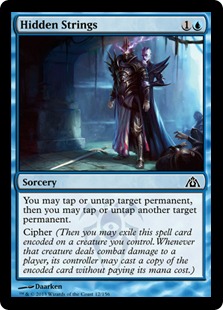As promised, today I want to give you a quick strategy primer for the deck. For reference, here is my current list:
AzAgCon
by gwyned
| Creatures 4 Cloudfin Raptor 4 Daring Skyjek 3 Syndic of Tithes 4 Vaporkin 2 Wavecrash Triton 3 Wingsteed Rider 4 Akroan Skyguard 24 cards Other Spells 4 Gods Willing 3 Essence Scatter 3 Hidden Strings 2 Mizzium Skin 1 Negate 1 Swift Justice 14 cards |
Lands 9 Island 9 Plains 4 Azorius Guildgate 22 cards
Sideboard
3 Keening Apparition 3 Celestial Flare 2 Hopeful Eidolon 2 Dispel 2 Beckon Apparition 1 Negate 1 Disperse 1 Essence Scatter 15 cards |

|
While this strategy is specifically geared for my life, most of this applies to any of the Crouching Cipher Hidden Strings lists.
The key to the deck is getting several good Heroic cards into play and then targeting them with Hidden Strings to either quickly boost their Power and Toughness or to lock down a key creature on your opponent's side of the board. With multiple ways of protecting your creatures that cost a single mana, it's worth waiting to play one of your Heroic creatures until you've got the extra mana to protect it. Cloudfin Raptor is also quite strong on Turn 1, as you often can pump it up to a 2/3 fairly quickly and force your opponent to deal with it instead of your more potent creatures. Syndic of Tithes also pairs extremely well with Hidden Strings, as you get a "free" trigger whenever the Cipher ability of Hidden Strings resolves.
Knowing when to cast Hidden Strings is probably the key to success with this deck. It can be used for a variety of purposes, especially on the turn it is initially cast:
- Tapping down an opponent's creature to enable you to activate Cipher that same turn
- Untapping your Lands to give you additional resources that turn
- Targeting (but not necessarily tapping) your own Heroic creatures; remember, just because you target it, doesn't mean you actually have to tap or untap it!
- Tapping down an opponent's untapped Land to cut her off from a color
The Sideboard is fairly straightforward. It includes some great Enchantment hate (Keening Apparition, Disperse), some spot removal (Celestial Flare), a bit of Graveyard recursion hate (Beckon Apparition) that can sometimes do double-duty against other aggressive archetypes, some helpful Lifegain (Hopeful Eidolon), and some additional counterspells (Essence Scatter, Negate, Dispel).
As I said last time, if you've never played this deck, it is both fun and surprisingly complex, with some interesting timing decisions to be made. Give it a try. Also, have a plan to deal with this archetype, as it seems to have grown in popularity!
Thanks for reading.

Nice deck tech, gwyned! I've only played a similar deck after MPDC 24.03 when I was defeated by Chris Baker and his original list and I was impressed by his deck. I think that splash of control and extra lands you added will give you an edge over most white based decks. I would go with Negates and/or Dispels in the main board instead of Essence Scatter, but I haven't tested this to be sure.
ReplyDeleteNice work!